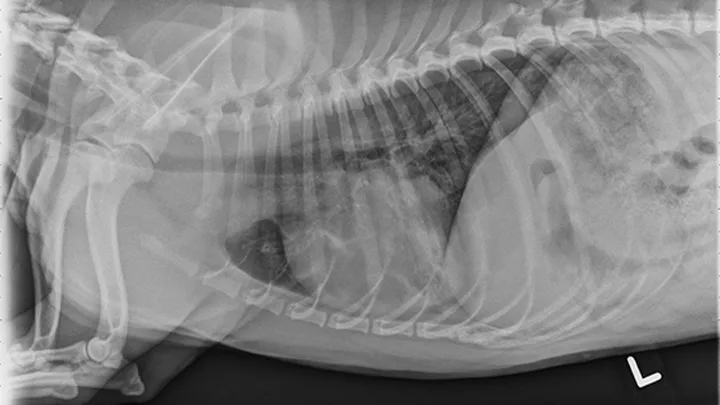Bordetella bronchiseptica
Jonathan Dear, DVM, MAS, DACVIM (SAIM), University of California, Davis

Doxycycline
Dogs: 5–10 mg/kg PO q12h for 2–4 weeks1-3Cats: 5 mg/kg PO q12h or 50 mg/cat q24h for 7–10 days1,4,5
Doxycycline is a tetracycline antibiotic that inhibits protein synthesis at the ribosomal level and remains the first-line antimicrobial therapy for bordetellosis in dogs and cats. Because of its bacteriostatic nature, doxycycline is not ideal for patients suspected of having pneumonia.6

Amoxicillin–Clavulanic Acid
Dogs: 13–20 mg/kg PO q12h for 2–4 weeks1-3,7Cats: 62.5 mg/cat PO q12h for 7–10 days1,7
Image (right). Left lateral thoracic radiograph of a dog with bronchopneumonia secondary to B bronchiseptica infection. Note the patchy interstitial to alveolar infiltrates in the dependent portions of the right middle and left cranial lobes.
Amoxicillin–clavulanic acid, a potentiated β-lactam antibiotic that inhibits cell wall synthesis, is a fair choice for patients with bordetellosis, as it is relatively broad-spectrum; however, resistance has been reported8-10 with increasing frequency.
Azithromycin
Azithromycin maintains good efficacy against a wide variety of respiratory pathogens.
Dogs: 5 mg/kg PO q24h for 5–7 days2,3Cats: 15 mg/kg PO q72h for 7–10 days or 5 mg/kg PO q24h for 3–5 days, then q72h up to 7–10 days5,11
As a macrolide, azithromycin inhibits protein synthesis by ribosomal binding. It maintains good efficacy against a wide variety of respiratory pathogens, including B bronchiseptica, and its slow elimination from the body allows for shorter treatment duration.
Enrofloxacin
Dogs: 5–10 mg/kg PO q24h for 2–4 weeks1,2,7Cats: 5 mg/kg PO q24h for 2–4 weeks1,7
Enrofloxacin, a quinolone antibiotic, has excellent tissue penetration within the respiratory tract12 and maintains good overall gram-negative coverage, inhibiting the enzyme DNA gyrase. In general, use of fluoroquinolones should be based on bacterial culture results and should not be considered first-line therapy. Because of potential for retinal toxicity, the label dose should never be exceeded in cats; other fluoroquinolones may be safer.13
Marbofloxacin
Dogs: 2.75–5.5 mg/kg PO q24h for 2–4 weeks12Cats: 2.75–5.5 mg/kg PO q24h for 2–4 weeks12
A third-generation fluoroquinolone, marbofloxacin acts via DNA gyrase inhibition and has a similar spectrum to enrofloxacin. In the U.S., the drug is primarily marketed for use in cats because of its reportedly lower incidence of retinal toxicity as compared with enrofloxacin, though these effects have still been reported, particularly in cats with renal insufficiency.12
Pradofloxacin
Dogs: Use contraindicated (U.S. label)14Cats: 7.5 mg/kg PO q24h for 2–4 weeks15-17
A third-generation fluoroquinolone with broad-spectrum bactericidal activity, pradofloxacin can be advantageous for the treatment of respiratory tract infections in cats, owing to its extended spectrum and fewer side effect incidents as compared with lower-generation fluoroquinolones. Pradofloxacin does not appear to be associated with retinal toxicity in cats but is contraindicated for use in dogs because of myelotoxicity potential and proarrhythmic effects.
Chloramphenicol
Dogs: 30–50 mg/kg PO q8h for 2–4 weeks1,12,18,19Cats: 50 mg/cat PO q12h for 1–3 weeks1,12,19
Chloramphenicol inhibits protein synthesis and can be bacteriostatic or bactericidal. It remains a good choice for serious infections (eg, pneumonia) in small animals, as its infrequent use has helped limit resistance. Because of idiosyncratic but rare incidence of aplastic anemia in humans, veterinarians should counsel owners to take precautions handling and administering.20
Treatment Choices
Antibiotics chosen for B bronchiseptica infection in the upper respiratory tract of dogs and cats may differ from those chosen for bronchopneumonia secondary to B bronchiseptica infection. A blood–bronchus barrier prevents penetration of certain antibiotics (eg, penicillins, aminoglycosides) as a function of pH, molecular size, and poor lipid solubility.
Many cases of B bronchiseptica infection are mild and self-limiting, thereby not requiring antiinfective therapy. Antimicrobial therapy should be reserved for patients with persistent clinical signs or evidence of bronchopneumonia or pediatric patients, as the disease can progress rapidly in young animals.6
In cases of persistent upper respiratory tract signs in the dog or cat, doxycycline for 7–10 days is considered the empiric antimicrobial of choice. Alternatives presented here describe other choices for patients with more severe tracheobronchitis or bronchopneumonia, and their use should be guided by bacterial culture and susceptibility when available.2,4,6